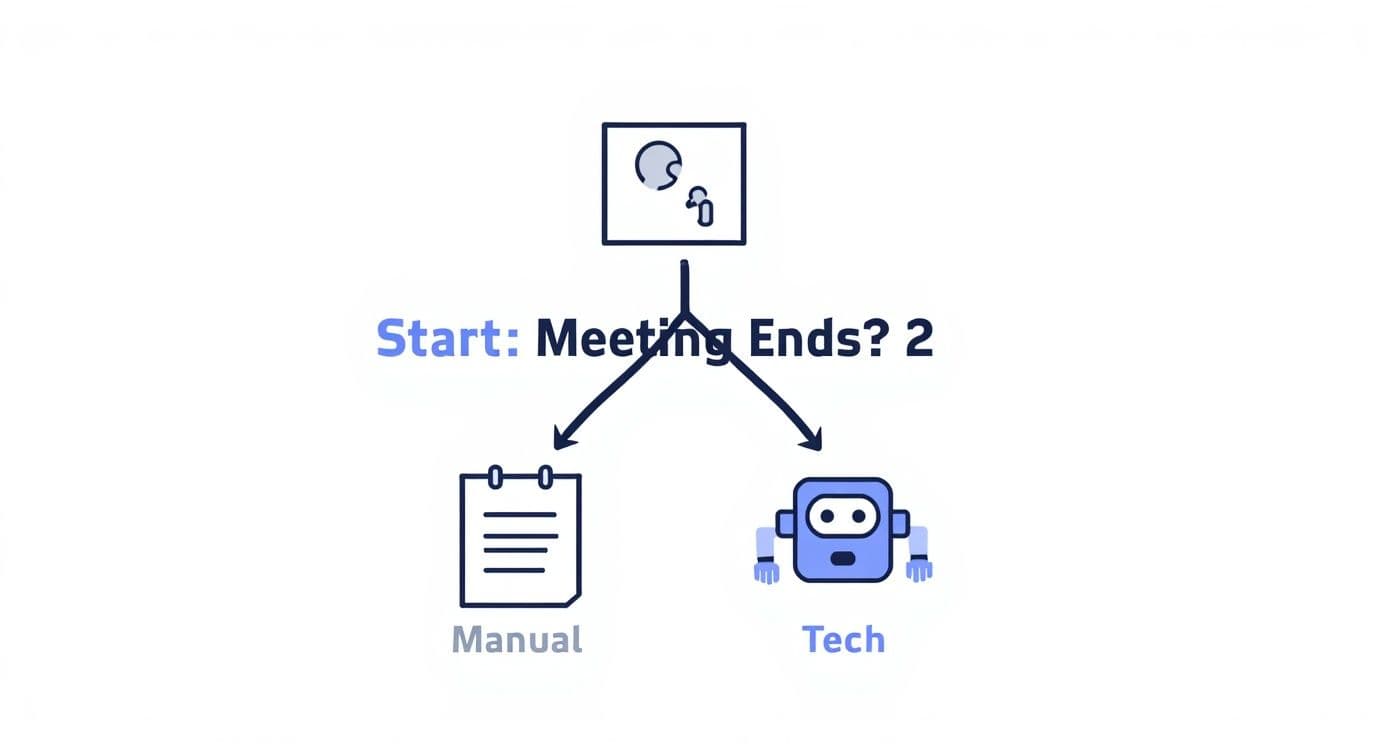Ever had a great meeting full of fantastic ideas, only to realize a week later that nothing actually happened? It's a classic problem. Action item tracking is how you fix it. It’s the simple, but powerful, process of capturing tasks from those conversations, giving them a clear owner, and making sure they get done. It’s what turns talk into results.
Why Action Item Tracking Is Your Team's Superpower

When a productive meeting ends, everyone often leaves with a fuzzy idea of what comes next. Before you know it, critical tasks have slipped through the cracks. This isn’t just a small hiccup; it’s a killer of momentum and a direct path to blown deadlines.
Good action item tracking is more than just jotting down notes. It’s about building a system—a single source of truth where every task has an owner, a deadline, and zero confusion. This creates a culture of accountability where everyone knows what they’re responsible for and can see how their work connects to the bigger picture.
The Cost of Ambiguity
Think about a project team finishing a client kickoff. The notes say, "Look into new design mockups" and "Finalize the project scope." Without clear assignments, what happens? The lead designer and the project manager both start working on the scope, duplicating their efforts. Meanwhile, the mockups sit untouched because each person thought someone else had it covered.
This kind of thing happens all the time, and it's incredibly wasteful. It leads directly to:
- Wasted Hours: Team members either double up on work or spend valuable time chasing down clarifications that should have been sorted out in the meeting.
- Missed Deadlines: Key dependencies get blocked because nobody was assigned to the first, most critical step.
- Frustration: Morale takes a hit when progress grinds to a halt simply because of poor communication and a lack of direction.
From Vague Ideas to Clear Actions
Proper action item tracking brings the structure needed to avoid this chaos. This isn't about micromanaging people; it's about creating shared clarity for the whole team. When done right, you establish a reliable workflow that fuels productivity and, just as importantly, builds trust.
To truly build a system that works, it helps to think about the core components. These are the foundational elements you need to get right.
The Four Pillars of Effective Action Item Tracking
This table breaks down the essential components of a robust tracking system, giving you a quick reference for building a foundation for success.
Getting these four pillars right is the first step toward turning messy follow-ups into a smooth, predictable process that everyone can rely on.
The impact is real. One tech company saw a 20% improvement in employee productivity after they got serious about their action item process. By tracking task completion, they could spot bottlenecks early and give team members the support they needed, which even helped reduce employee turnover. You can find more details on how performance tracking boosts team results on Assessteam. This shows that tracking isn't just admin work—it's a strategic advantage.
How to Capture Action Items Before They Vanish
We’ve all been there. A great meeting wraps up, everyone feels energized, but an hour later, the brilliant ideas and crucial next steps are already getting fuzzy. That feeling of, "Wait, what were we supposed to do again?" is a classic sign that momentum is dying.
The key to keeping that energy alive is to capture action items the moment they’re created. It’s not just about taking better notes; it's about having a deliberate system that acts as a safety net, catching every commitment before it slips through the cracks. This turns a chaotic brainstorm into a real, actionable plan.
The Old-School Methods That Still Work
Before you jump to the latest tech, it’s worth mastering the basics. These hands-on methods build a rock-solid foundation for accountability, and they work just as well around a whiteboard as they do in a high-tech conference room. They enforce a discipline that new tools can supercharge, but never fully replace.
One of the simplest and most powerful techniques is to assign a dedicated "action owner" for the meeting. This isn't the minute-taker. This person’s only job is to listen for commitments. When someone says, "I'll look into that," the action owner steps in to clarify and document it. "Okay, so Alex is researching competitor pricing, due by Friday. Is that right?"
Getting that verbal confirmation on the spot is crucial. It cuts through ambiguity and turns a casual comment into a concrete task.
Another trick is to build capture points right into your meeting agenda. Instead of a generic "Q&A" at the end, make space for the outcomes:
- Decisions Made: A clear, bulleted list of what was agreed upon.
- Key Takeaways: The big-picture insights everyone should remember.
- Action Items & Owners: The dedicated spot to log every task, who owns it, and when it’s due.
When you structure your agenda this way, capturing outputs becomes a natural part of the meeting’s flow, not a frantic afterthought.
Using Tech to Capture Everything Effortlessly
While the manual methods are solid, modern tools can do the heavy lifting for you, ensuring nothing gets missed in a fast-paced conversation. AI meeting assistants and transcription services have gone from novelties to essentials for any team that's serious about follow-through.
These tools can join your calls, transcribe everything that's said, and use AI to automatically pull out tasks. They’re smart enough to distinguish speakers, understand context, and flag phrases like "I will follow up on..." or "The next step is..." to create a clean list of action items. This frees everyone up to actually participate in the conversation instead of burying their heads in a notepad.
A Real-World Example
Imagine a marketing team brainstorming a new product launch. The energy is high, and ideas are flying everywhere. Trying to capture it all by hand would be a nightmare.
Here’s how an AI assistant changes the game:
- It records and transcribes: Every single word from every person is captured perfectly.
- It spots commitments: The tool flags it when the content lead says, "I'll draft the blog post announcement by Wednesday," and when the social media manager promises to "create a content calendar for the launch week."
- It generates a summary: Minutes after the meeting ends, an email lands in everyone’s inbox. It has a quick summary, the full transcript, and a neatly organized list of action items, complete with who owns them and the exact moment they were mentioned.
This process takes a potentially messy brainstorm and turns it into a structured plan. The team can drop these tasks right into their project management tool without losing a single detail. If you're just getting started, using a framework can make a huge difference, and you can explore a meeting action items template that actually works to build that solid foundation.
Building Your Central Action Item Tracking Hub
Jotting down an action item is easy. Making sure it actually gets done? That's the hard part. If those critical next steps end up scattered across personal notebooks, random Slack DMs, or buried in a week-old email thread, they’re as good as forgotten. What you need is a central hub—a single source of truth for your entire team.
This hub gives everyone a clear, shared view of every commitment, deadline, and owner. Without it, you’re just creating ambiguity. It's no surprise that teams often complete fewer than half of their identified action items; there's simply no system to hold anyone accountable. A central hub is that system. It turns good intentions into a workflow you can actually track.
Choosing the Right Tool for Your Team
The "best" tool for tracking action items really depends on your team's specific reality—your size, your budget, and how complex your projects are. What works brilliantly for a three-person startup will almost certainly crash and burn in a 50-person engineering department.
To help you navigate the options, here's a quick comparison of the most common tool types. Each has its place, and finding the right fit is about matching the tool's strengths to your team's unique workflow and challenges.
Choosing the Right Action Item Tracking Tool
Ultimately, the goal is to pick a tool that feels natural for your team to use. If it's too cumbersome or complicated, people will simply revert to their old habits of scribbling notes on a pad of paper.
This infographic lays out the typical paths teams take to manage their action items after a meeting, ranging from the most basic manual methods to more powerful, tech-driven solutions.

The real takeaway here is about finding the right balance. You have to weigh the simplicity of manual tracking against the power (and potential learning curve) of dedicated software.
Setting Up Your Action Item Framework
Once you’ve picked your tool, the next step is to create a consistent structure. Every single action item should capture the same essential information. This consistency is your secret weapon—it makes it incredibly easy for anyone to scan the list and understand the team’s workload at a glance.
Make sure every task you create has these five core components:
- A Clear Description: "Update website" is useless. "Draft and publish new blog post on Q3 product updates" leaves no room for confusion.
- A Single Owner: Assigning a task to "The Marketing Team" is a recipe for disaster. Every action item needs one person who is ultimately responsible for getting it done.
- A Firm Due Date: A task without a deadline is just a suggestion floating in the ether. A specific date creates accountability and helps with prioritization.
- A Priority Level: A simple High, Medium, or Low system is all you need. It helps the team know exactly where to focus when time is tight.
- A Current Status: At a bare minimum, you need "To-Do," "In Progress," and "Done." This gives everyone instant visibility into where things stand.
Integrating Your Hub for Maximum Efficiency
Your tracking hub shouldn't be a lonely island. To get the most out of it, connect it with the tools your team already lives in every day. When your task board can talk to your chat app and your calendar, you eliminate tedious manual entry and dramatically reduce the chance of things falling through the cracks.
For example, you could connect your project management tool to Slack, allowing anyone to create an action item directly from a conversation. Many platforms also offer integrations that can automate your entire workflow.
If you're curious about connecting different apps, our ClickUp integrations guide walks through how to link platforms together and even bring AI meeting tools into the mix for a completely seamless setup.
Using Automation and AI for Smarter Tracking

Let's be honest, a great action item system shouldn't feel like a second job. If your team is spending more time updating statuses than actually doing the work, the system is broken. The whole point is to make tracking an invisible, seamless part of the day—not another manual chore.
This is where automation and AI really shine. By connecting the tools your team already lives in, you can build a system that practically runs itself. We're not talking about complex coding, just simple rules and integrations that handle the repetitive, boring stuff for you.
Automate the Nudges and Reminders
Think about one of the biggest time-sucks in any project: chasing people for updates. The "Hey, what's the status on this?" Slack message is a productivity killer. You can wipe this out completely by setting up automated reminders in your project management tool.
For instance, you could create a simple rule: send the assignee a notification two days before a due date. If the task slips into overdue territory, another alert goes to both the assignee and their manager. Simple, right?
This one small change does two massive things:
- It keeps people accountable without confrontation. The system is doing the reminding, not a person. It feels less like nagging and more like a helpful nudge.
- It frees up mental energy. No one has to keep a mental checklist of who to follow up with. The system handles it so team leads can focus on work that matters.
Connect Your Workflow with Integrations
Your action item hub becomes infinitely more useful when it can talk to your other apps. Integrations are the bridges that let different tools share information automatically, killing the need to copy-paste data between systems. This turns a static to-do list into a living, breathing operational center.
A classic move is integrating your project management tool with a chat app like Slack or Microsoft Teams. Imagine a conversation where a clear action item pops up. Instead of someone having to switch windows to manually create a task, they can use a simple command to turn that message directly into an assigned action item.
Making it effortless to capture tasks right where the conversation happens is a game-changer for adoption. You dramatically increase the odds that nothing falls through the cracks. It's all about meeting your team where they are.
Leverage AI for Predictive Insights
Beyond simple if-then automation, AI is bringing a new layer of intelligence to the table. Modern AI systems can actually analyze your team's past performance to spot patterns and predict roadblocks before they derail your project.
This isn't sci-fi; it's already happening. A PwC survey found that 53% of organizations use AI to anticipate supply chain issues, and a staggering 98% of leaders said digital tools gave them better operational visibility. The same logic is now being applied to team workflows.
Some advanced platforms can now flag a task as "at-risk" if the assignee is overloaded or if similar tasks have historically run late. This lets a manager step in proactively to reallocate resources or adjust a deadline before a small delay snowballs.
Tools are also getting incredibly good at action item extraction directly from meeting transcripts, so nothing gets lost in translation. To see just how far this can go, check out what’s possible with AI-powered workflow automation.
How to Measure Success and Foster Accountability
Let's be honest: an action item tracking system is just a fancy to-do list if it doesn't actually get things done. The point isn't just to write down tasks—it's to build a culture of ownership and see real, measurable progress. Without a way to measure what’s working, you're flying blind.
To get beyond simply logging tasks and start driving actual results, you need to focus on what matters. This means zeroing in on a few data points that tell the story of your team's reliability and efficiency. This isn't about micromanaging; it's about using clear data to have helpful, forward-looking conversations.
Key Metrics for Action Item Tracking
Instead of drowning in data, you can get a great snapshot of how things are going with just a few key performance indicators (KPIs). Most modern project management tools even have dashboards that show you these numbers at a glance, so you can spot trends without living in spreadsheets.
I'd recommend starting with these three:
- On-Time Completion Rate: This is your most direct measure of accountability. What percentage of action items gets done by the original due date? If the rate is consistently high, your team is nailing their estimates and commitments. If it’s dipping, it might point to unrealistic deadlines or hidden obstacles.
- Average Time to Completion: How long, on average, does it take for an action item to move from "assigned" to "done"? A downward trend is a great sign of increasing efficiency. If that number starts to creep up, it could be a sign of a bottleneck in your process or even team burnout.
- Number of Overdue Tasks: This is your real-time health check. A couple of overdue tasks here and there is normal, but a growing pile of them is a big red flag that you need to address in your next team huddle.


